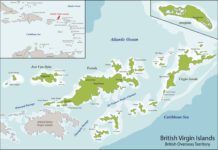When cruising the Bahamas, youll need three flags: a yellow quarantine flag, your home countrys flag, and a Bahamian courtesy flag. When nearing your port of entry, hoist the yellow quarantine flag and report to a Customs and Immigration facility as soon as possible after entering Bahamian waters.
Once docked or anchored, only the captain is allowed to go ashore to meet with Customs and Immigration to clear the vessel; all other crewmembers must stay aboard until this is completed.In addition to the ships documentation/registration paperwork, the captain should also take passports for all persons aboard, an import permit for any pets, and information on any firearms onboard (make, model, serial number, number of rounds of ammunition, etc.). Leave all firearms on the boat; do not take them with you while clearing in.
We also recommend that you dress neatly, and always treat officials with courtesy and respect-you are a guest in their country after all. Things move at a slower pace in the islands than you may be accustomed to; expect it and don’t get flustered about it. Youll find a smile and common courtesy will serve you well during the process, but a bad attitude may add to any delays. After clearing in and receiving your cruising permit, take down the yellow Q flag and hoist your Bahamian courtesy flag, which should remain flying during the length of your stay.
Costs
For pleasure boats arriving in the Bahamas, the fee is $150 for those under 30 feet or $300 for boats over 30 feet. This covers the cost of the initial-entry cruising permit, plus a return visit within 90 days. It also includes a three-month fishing permit and any attendant fees payable to a Customs officer (overtime and travel costs required for the attendance of an officer). Your entry fee also pays the $20 departure tax should you need to fly home; be sure to take a copy of your cruising permit to the airport, if this is the case.
The fee covers entry for three persons. Each additional person will be charged $20; however, there is no charge for children under 6 years old. Its a good idea to verify all fees by contacting Bahamas Customs prior to departing the U.S.
Exiting Bahamas, entering U.S.
You don’t have to clear out of the Bahamas when heading back to the good ole US of A, but you do have to clear in with U.S. Customs and Immigration. The easiest way to do this is by registering with the Small Vessel Reporting System (SVRS) (aka the Local Boater Option) before heading over to the Bahamas. The benefit here is that you can likely clear in over the phone (if all requirements are met). U.S. vessels longer than 30 feet must also display a Customs User Fee Decal and be prepared to give the decal number when clearing back in to the U.S. This can also be purchased online and in advance of your cruise using the Decal and Transponder Online Procurement System (DTOPS).
Here are some helpful resources:
Bahamas Customs:
www.bahamas.com/boating-enter-exit
Small Vessel Reporting System:
https://svrs.cbp.dhs.gov/default.aspx
Decal / Transponder Online Procurement System:
https://dtops.cbp.dhs.gov/boating-enter-exit
Small Vessel Reporting System:
https://svrs.cbp.dhs.gov/default.aspx
Decal / Transponder Online Procurement System:




































